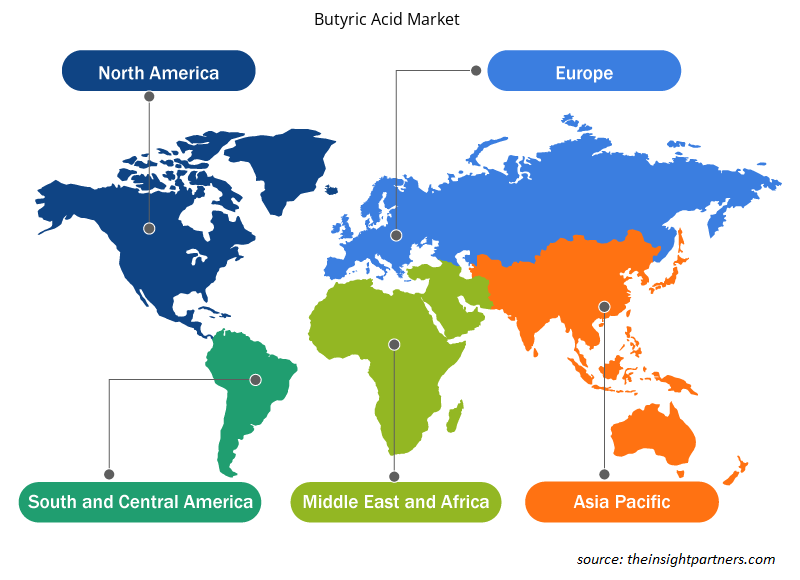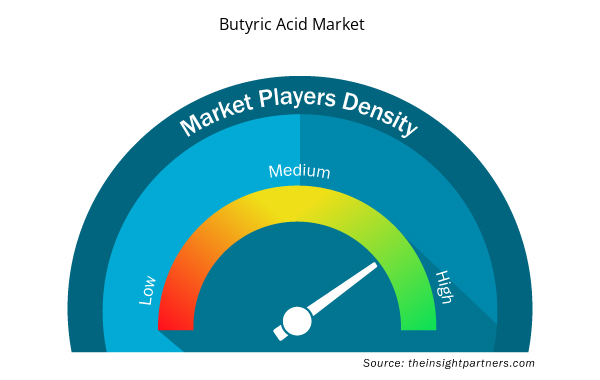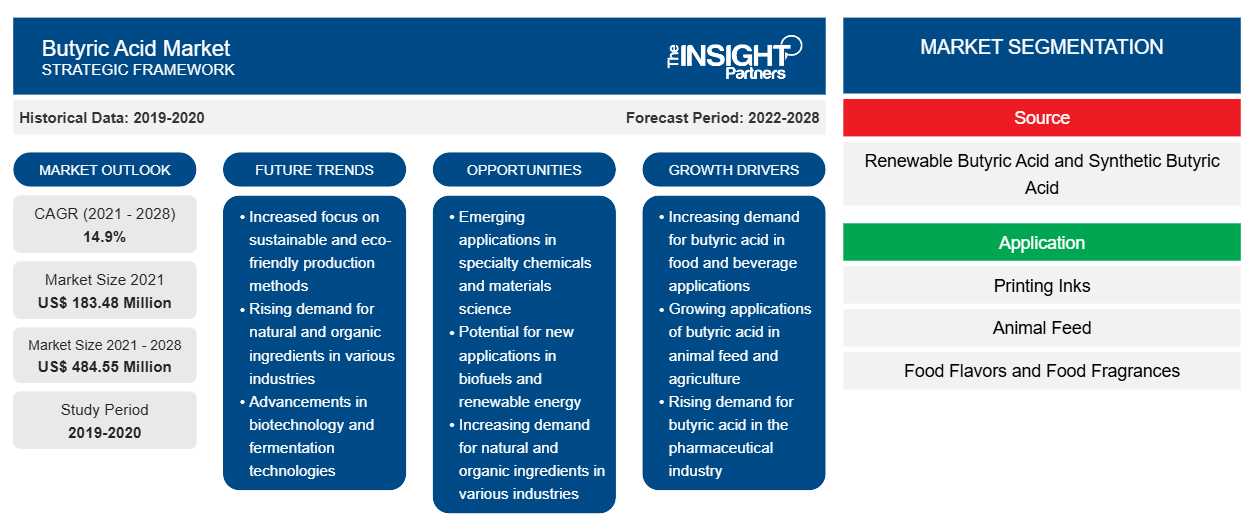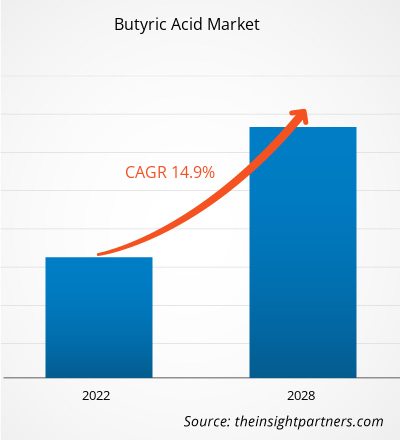Der Markt für Buttersäure hatte im Jahr 2021 einen Wert von 183,48 Millionen US-Dollar und soll bis 2028 einen Wert von 484,55 Millionen US-Dollar erreichen; von 2021 bis 2028 wird ein durchschnittliches jährliches Wachstum von 14,9 % erwartet.
Buttersäure ist eine farblose Flüssigkeit mit einem penetranten und unangenehmen Geruch. Die Säure hat verschiedene wichtige Anwendungen in der Chemie-, Lebensmittel- und Pharmaindustrie. Buttersäure hat viele Anwendungen in der Pharmaindustrie.
Im Jahr 2020 hatte der asiatisch-pazifische Raum den größten Umsatzanteil am Weltmarkt. Die wachsende Zahl von Viehzuchtbetrieben im asiatisch-pazifischen Raum erhöht den Verbrauch von Tierfutter und lässt in der Folge den Buttersäuremarkt wachsen . Das Wachstum der Viehzuchtbetriebe im asiatisch-pazifischen Raum ist auf die gestiegene Nachfrage nach hochwertigen Fleischprodukten aufgrund des steigenden Pro-Kopf-Einkommens und des wachsenden Gesundheitsbewusstseins der Verbraucher im asiatisch-pazifischen Raum zurückzuführen.
Passen Sie diesen Bericht Ihren Anforderungen an
Sie erhalten kostenlos individuelle Anpassungen an jedem Bericht, einschließlich Teilen dieses Berichts oder einer Analyse auf Länderebene, eines Excel-Datenpakets sowie tolle Angebote und Rabatte für Start-ups und Universitäten.
- Holen Sie sich die wichtigsten Markttrends aus diesem Bericht.Dieses KOSTENLOSE Beispiel umfasst eine Datenanalyse von Markttrends bis hin zu Schätzungen und Prognosen.
Auswirkungen der COVID-19-Pandemie auf den Buttersäuremarkt
Die COVID-19-Pandemie hat sich aufgrund von Lockdowns, Reiseverboten und Betriebsschließungen negativ auf die Wirtschaft und Industrie in verschiedenen Ländern ausgewirkt. Im Jahr 2020 mussten verschiedene Industrien ihren Betrieb aufgrund von Störungen in den Wertschöpfungsketten aufgrund der Schließung nationaler und internationaler Grenzen verlangsamen, was die Nachfrage nach Buttersäure einschränkte. Die COVID-19-Pandemie führte zu Preisschwankungen bei den zur Herstellung von Buttersäure benötigten Rohstoffen. Der weltweite Verbrauch von Buttersäure ging aufgrund der geringen Nachfrage aus verschiedenen nachgelagerten Sektoren zurück, wie z. B. Lebensmittelaromen, Lebensmittelduftstoffen und chemischen Zwischenprodukten. Die eingeschränkte Verfügbarkeit der Rohstoffe und die geringere Nachfrage aus den nachgelagerten Sektoren aufgrund der COVID-19-Pandemie haben sich negativ auf das Wachstum des Buttersäuremarktes ausgewirkt.
Markteinblicke
Steigende Nachfrage aus dem Tierfuttersektor
Buttersäure ist für ihre positiven Auswirkungen auf die Darmgesundheit und -entwicklung bekannt. Seit Jahrzehnten wird sie in der Tierfutterindustrie verwendet, um die Darmgesundheit und die Leistungsfähigkeit der Tiere zu verbessern. Darüber hinaus ist Buttersäure für die Produzenten von Broilern, Legehennen, Truthähnen und Schweinen zu einer Antibiotikaalternative erster Wahl geworden, da die Tierfutterindustrie den Einsatz von Antibiotika reduzieren will.
In den letzten Jahren hat die Viehwirtschaft in verschiedenen Ländern mit der Verschiebung der Ernährungspräferenzen der Verbraucher hin zu tierischen Proteinen stark zugenommen. Bevölkerungswachstum, Einkommenszuwachs, steigender Lebensstandard und Urbanisierung sind die Schlüsselfaktoren, die die Nachfrage nach Fleisch weltweit ankurbeln. Die steigende Nachfrage nach Fleischprodukten unterstreicht den Bedarf an Tierfutter und Futterzusätzen. Die wachsende Nachfrage nach Tierfutterprodukten in verschiedenen Regionen steigert die Nachfrage nach Buttersäure und fördert damit das Wachstum des Buttersäuremarktes.
Buttersäure ist eine der vorteilhaftesten kurzkettigen Fettsäuren, die eine Schlüsselrolle bei der Verbesserung der Verdauungsgesundheit, der Gewichtskontrolle und der Krebsvorbeugung spielt. Das starke Wachstum der Pharmaindustrie in verschiedenen Ländern weltweit führt zu einer zunehmenden Nutzung von Buttersäure für verschiedene Anwendungen. Darüber hinaus besteht ein zunehmendes Interesse daran, Buttersäure als Vorläufer für die Herstellung von Biokraftstoffen zu verwenden. Dies dürfte im Prognosezeitraum lukrative Möglichkeiten für das Wachstum des Buttersäuremarktes bieten.
Quelle Einblicke
Basierend auf der Quelle wurde der globale Buttersäuremarkt in erneuerbare Buttersäure und synthetische Buttersäure segmentiert. Das Segment der synthetischen Buttersäure hatte im Jahr 2020 einen größeren Anteil am Weltmarkt. Das Segment der synthetischen Buttersäure nimmt den größten Anteil ein, da es unter anderem für die Herstellung von Druckfarben, Desinfektionsmitteln, Aromen, Medikamenten, Parfüms, Ostern und Lebensmittelzusatzstoffen verwendet wird.
Zu den Akteuren auf dem globalen Buttersäuremarkt gehören unter anderem Eastman Chemical Company; OQ Chemicals GmbH; Tokyo Chemical Industry Co., Ltd.; Perstorp Holding AB; Alfa Aesar; MERCK KGaA; Vigon International, LLC.; Hefei TNJ Chemical Industry Co.,Ltd.; KUNSHAN ODOWELL CO.,LTD; und Yufeng International Co.,Ltd. Die Akteure auf dem Buttersäuremarkt konzentrieren sich auf die Bereitstellung hochwertiger Produkte, um die Kundennachfrage zu erfüllen. Diese Marktteilnehmer konzentrieren sich stark auf die Entwicklung hochwertiger und innovativer Serviceangebote, um die Anforderungen der Kunden zu erfüllen.
Regionale Einblicke in den Buttersäuremarkt
Die regionalen Trends und Faktoren, die den Buttersäuremarkt im Prognosezeitraum beeinflussen, wurden von den Analysten von Insight Partners ausführlich erläutert. In diesem Abschnitt werden auch Buttersäuremarktsegmente und -geografie in Nordamerika, Europa, im asiatisch-pazifischen Raum, im Nahen Osten und Afrika sowie in Süd- und Mittelamerika erörtert.

- Erhalten Sie regionalspezifische Daten zum Buttersäuremarkt
Umfang des Buttersäure-Marktberichts
| Berichtsattribut | Details |
|---|---|
| Marktgröße im Jahr 2021 | 183,48 Millionen US-Dollar |
| Marktgröße bis 2028 | 484,55 Millionen US-Dollar |
| Globale CAGR (2021 - 2028) | 14,9 % |
| Historische Daten | 2019-2020 |
| Prognosezeitraum | 2022–2028 |
| Abgedeckte Segmente | Nach Quelle
|
| Abgedeckte Regionen und Länder | Nordamerika
|
| Marktführer und wichtige Unternehmensprofile |
|
Dichte der Marktteilnehmer für Buttersäure: Deren Auswirkungen auf die Geschäftsdynamik verstehen
Der Markt für Buttersäure wächst rasant, angetrieben durch die steigende Nachfrage der Endverbraucher aufgrund von Faktoren wie sich entwickelnden Verbraucherpräferenzen, technologischen Fortschritten und einem größeren Bewusstsein für die Vorteile des Produkts. Mit steigender Nachfrage erweitern Unternehmen ihr Angebot, entwickeln Innovationen, um die Bedürfnisse der Verbraucher zu erfüllen, und nutzen neue Trends, was das Marktwachstum weiter ankurbelt.
Die Marktteilnehmerdichte bezieht sich auf die Verteilung von Firmen oder Unternehmen, die in einem bestimmten Markt oder einer bestimmten Branche tätig sind. Sie gibt an, wie viele Wettbewerber (Marktteilnehmer) in einem bestimmten Marktraum im Verhältnis zu seiner Größe oder seinem gesamten Marktwert präsent sind.
Die wichtigsten auf dem Buttersäuremarkt tätigen Unternehmen sind:
- Eastman Chemical Company
- OQ Chemicals GmbH
- Tokio Chemieindustrie Co., Ltd.
- Perstorp Holding AB
- Alfa Aesar
Haftungsausschluss : Die oben aufgeführten Unternehmen sind nicht in einer bestimmten Reihenfolge aufgeführt.

- Überblick über die wichtigsten Akteure auf dem Buttersäuremarkt
Bericht-Spotlights
- Fortschrittliche Branchentrends auf dem Buttersäuremarkt helfen den Akteuren bei der Entwicklung wirksamer langfristiger Strategien
- In Industrie- und Entwicklungsländern angewandte Strategien für Unternehmenswachstum
- Quantitative Analyse des Buttersäuremarktes von 2019 bis 2028
- Schätzung der weltweiten Nachfrage nach HR-PIB
- Porters Fünf-Kräfte-Analyse zur Veranschaulichung der Wirksamkeit der in der Branche tätigen Käufer und Lieferanten
- Aktuelle Entwicklungen zum Verständnis des Wettbewerbsmarktszenarios
- Markttrends und -aussichten sowie Faktoren, die das Wachstum des Buttersäuremarktes vorantreiben und bremsen
- Unterstützung im Entscheidungsprozess durch Aufzeigen von Marktstrategien, die das kommerzielle Interesse untermauern und zum Marktwachstum führen
- Die Größe des Buttersäuremarktes an verschiedenen Knotenpunkten
- Detaillierte Übersicht und Segmentierung des Marktes sowie der HR-PIB-Branchendynamik
- Größe des Buttersäuremarktes in verschiedenen Regionen mit vielversprechenden Wachstumschancen
Globaler Buttersäuremarkt
Quelle
- Erneuerbare Buttersäure
- Synthetische Buttersäure
Anwendung
- Druckfarben
- Tierfutter
- Lebensmittelaromen und Lebensmitteldüfte
- Chemische Zwischenprodukte
- Pharmazeutische
- Sonstiges
Firmenprofile
- Eastman Chemical Company
- OQ Chemicals GmbH
- Tokio Chemieindustrie Co., Ltd.
- Perstorp Holding AB
- Alfa Aesar
- MERCK KGaA
- Vigon International, LLC.
- Hefei TNJ Chemieindustrie Co., Ltd.
- KUNSHAN ODOWELL CO., LTD
- Yufeng International Co., Ltd.
- Historische Analyse (2 Jahre), Basisjahr, Prognose (7 Jahre) mit CAGR
- PEST- und SWOT-Analyse
- Marktgröße Wert/Volumen – Global, Regional, Land
- Branche und Wettbewerbsumfeld
- Excel-Datensatz



Report Coverage
Revenue forecast, Company Analysis, Industry landscape, Growth factors, and Trends

Segment Covered
This text is related
to segments covered.

Regional Scope
North America, Europe, Asia Pacific, Middle East & Africa, South & Central America

Country Scope
This text is related
to country scope.
Häufig gestellte Fragen
Growing demand for butyric acid from animal feed sector is one of the major driving factors for the market. Butyric acid is known for its beneficial effects on gut health and development. For decades, it has been in use in the animal feed industry for ensuring improved gut health and animal performance. The use of butyric acid in animal nutrition also helps in improving nutrient absorption.
Asia Pacific (APAC) is anticipated to grow with the fastest CAGR at rate of 15.3% from 2021 to 2028. The growing number of livestock farms in APAC is propelling animal feed consumption levels, subsequently leading to the proliferation of the butyric acid market.
Due to the COVID-19 pandemic, butyric acid manufacturers witnessed a slight disruption in the supply chain of butyric acid during the first two quarters of 2020. However, the supply chain of butyric acid materials has been restored, and production activities have regained normalcy in late 2020. Later, the market was not significantly negatively impacted by the pandemic. Further, with the growing COVID-19 vaccinations and eased in lockdown restrictions, the global economy is resuming, and subsequently, the butyric acid market is regaining its growth.
Based on application, the animal feed segment accounted the largest share of the global butyric acid market. Butyric acid and fatty acids are extensively used in production of poultry and swine feed due to its beneficial properties such as improving digestibility, better colonisation resistance, and improved growth performance among young livestock.
The major players operating in the global butyric acid market are Eastman Chemical Company; OQ Chemicals GmbH; Tokyo Chemical Industry Co., Ltd.; Perstorp Holding AB; Alfa Aesar; MERCK KGaA; Vigon International, LLC.; Hefei TNJ Chemical Industry Co.,Ltd.; KUNSHAN ODOWELL CO.,LTD; and Yufeng International Co.,Ltd.
During the forecast period, Asia Pacific is anticipated to account for the largest share in the global butyric acid market. The region houses few of the fastest developing economies of the world such as China and India and that are the major consumer of the butyric acid. Moreover, in the Asia Pacific region, there is a growing number of livestock farms which is increasing the consumption of animal feed and subsequently proliferating the butyric acid market.
Trends and growth analysis reports related to Chemicals and Materials : READ MORE..
The List of Companies_ Butyric Acid Market
- Eastman Chemical Company
- OQ Chemicals GmbH
- Tokyo Chemical Industry Co., Ltd.
- Perstorp Holding AB
- Alfa Aesar
- MERCK KGaA
- Vigon International, LLC.
- Hefei TNJ Chemical Industry Co.,Ltd.
- KUNSHAN ODOWELL CO.,LTD
- Yufeng International Co.,Ltd
The Insight Partners performs research in 4 major stages: Data Collection & Secondary Research, Primary Research, Data Analysis and Data Triangulation & Final Review.
- Data Collection and Secondary Research:
As a market research and consulting firm operating from a decade, we have published and advised several client across the globe. First step for any study will start with an assessment of currently available data and insights from existing reports. Further, historical and current market information is collected from Investor Presentations, Annual Reports, SEC Filings, etc., and other information related to company’s performance and market positioning are gathered from Paid Databases (Factiva, Hoovers, and Reuters) and various other publications available in public domain.
Several associations trade associates, technical forums, institutes, societies and organization are accessed to gain technical as well as market related insights through their publications such as research papers, blogs and press releases related to the studies are referred to get cues about the market. Further, white papers, journals, magazines, and other news articles published in last 3 years are scrutinized and analyzed to understand the current market trends.
- Primary Research:
The primarily interview analysis comprise of data obtained from industry participants interview and answers to survey questions gathered by in-house primary team.
For primary research, interviews are conducted with industry experts/CEOs/Marketing Managers/VPs/Subject Matter Experts from both demand and supply side to get a 360-degree view of the market. The primary team conducts several interviews based on the complexity of the markets to understand the various market trends and dynamics which makes research more credible and precise.
A typical research interview fulfils the following functions:
- Provides first-hand information on the market size, market trends, growth trends, competitive landscape, and outlook
- Validates and strengthens in-house secondary research findings
- Develops the analysis team’s expertise and market understanding
Primary research involves email interactions and telephone interviews for each market, category, segment, and sub-segment across geographies. The participants who typically take part in such a process include, but are not limited to:
- Industry participants: VPs, business development managers, market intelligence managers and national sales managers
- Outside experts: Valuation experts, research analysts and key opinion leaders specializing in the electronics and semiconductor industry.
Below is the breakup of our primary respondents by company, designation, and region:

Once we receive the confirmation from primary research sources or primary respondents, we finalize the base year market estimation and forecast the data as per the macroeconomic and microeconomic factors assessed during data collection.
- Data Analysis:
Once data is validated through both secondary as well as primary respondents, we finalize the market estimations by hypothesis formulation and factor analysis at regional and country level.
- Macro-Economic Factor Analysis:
We analyse macroeconomic indicators such the gross domestic product (GDP), increase in the demand for goods and services across industries, technological advancement, regional economic growth, governmental policies, the influence of COVID-19, PEST analysis, and other aspects. This analysis aids in setting benchmarks for various nations/regions and approximating market splits. Additionally, the general trend of the aforementioned components aid in determining the market's development possibilities.
- Country Level Data:
Various factors that are especially aligned to the country are taken into account to determine the market size for a certain area and country, including the presence of vendors, such as headquarters and offices, the country's GDP, demand patterns, and industry growth. To comprehend the market dynamics for the nation, a number of growth variables, inhibitors, application areas, and current market trends are researched. The aforementioned elements aid in determining the country's overall market's growth potential.
- Company Profile:
The “Table of Contents” is formulated by listing and analyzing more than 25 - 30 companies operating in the market ecosystem across geographies. However, we profile only 10 companies as a standard practice in our syndicate reports. These 10 companies comprise leading, emerging, and regional players. Nonetheless, our analysis is not restricted to the 10 listed companies, we also analyze other companies present in the market to develop a holistic view and understand the prevailing trends. The “Company Profiles” section in the report covers key facts, business description, products & services, financial information, SWOT analysis, and key developments. The financial information presented is extracted from the annual reports and official documents of the publicly listed companies. Upon collecting the information for the sections of respective companies, we verify them via various primary sources and then compile the data in respective company profiles. The company level information helps us in deriving the base number as well as in forecasting the market size.
- Developing Base Number:
Aggregation of sales statistics (2020-2022) and macro-economic factor, and other secondary and primary research insights are utilized to arrive at base number and related market shares for 2022. The data gaps are identified in this step and relevant market data is analyzed, collected from paid primary interviews or databases. On finalizing the base year market size, forecasts are developed on the basis of macro-economic, industry and market growth factors and company level analysis.
- Data Triangulation and Final Review:
The market findings and base year market size calculations are validated from supply as well as demand side. Demand side validations are based on macro-economic factor analysis and benchmarks for respective regions and countries. In case of supply side validations, revenues of major companies are estimated (in case not available) based on industry benchmark, approximate number of employees, product portfolio, and primary interviews revenues are gathered. Further revenue from target product/service segment is assessed to avoid overshooting of market statistics. In case of heavy deviations between supply and demand side values, all thes steps are repeated to achieve synchronization.
We follow an iterative model, wherein we share our research findings with Subject Matter Experts (SME’s) and Key Opinion Leaders (KOLs) until consensus view of the market is not formulated – this model negates any drastic deviation in the opinions of experts. Only validated and universally acceptable research findings are quoted in our reports.
We have important check points that we use to validate our research findings – which we call – data triangulation, where we validate the information, we generate from secondary sources with primary interviews and then we re-validate with our internal data bases and Subject matter experts. This comprehensive model enables us to deliver high quality, reliable data in shortest possible time.


 Holen Sie sich ein kostenloses Muster für diesen Bericht
Holen Sie sich ein kostenloses Muster für diesen Bericht